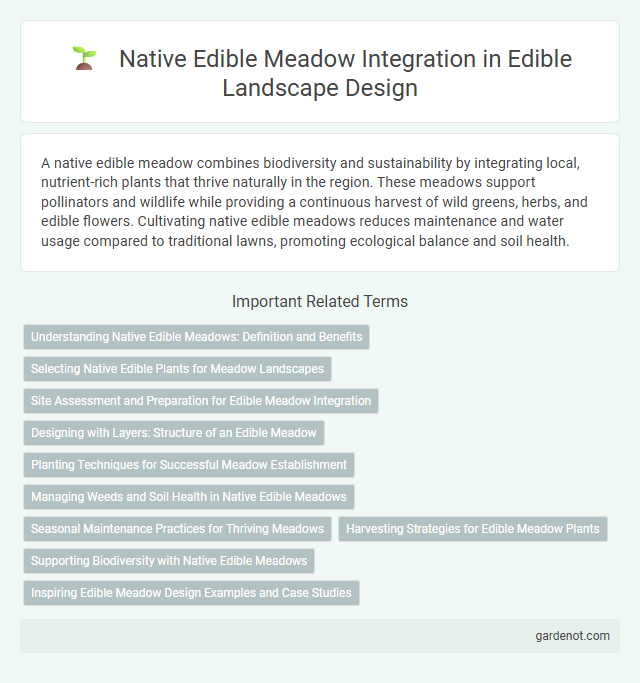A native edible meadow combines biodiversity and sustainability by integrating local, nutrient-rich plants that thrive naturally in the region. These meadows support pollinators and wildlife while providing a continuous harvest of wild greens, herbs, and edible flowers. Cultivating native edible meadows reduces maintenance and water usage compared to traditional lawns, promoting ecological balance and soil health.
Understanding Native Edible Meadows: Definition and Benefits
Native edible meadows are ecosystems composed of indigenous plants that provide nutritious, foraged food sources while supporting local biodiversity. These meadows improve soil health through natural nutrient cycling and reduce the need for synthetic inputs by fostering resilient plant communities adapted to regional climates. Incorporating native edible meadows into landscapes promotes sustainable food production and enhances habitat for pollinators, birds, and beneficial insects.
Selecting Native Edible Plants for Meadow Landscapes
Selecting native edible plants for meadow landscapes enhances biodiversity while providing sustainable food sources. Species such as wild strawberries (Fragaria virginiana), black-eyed susans (Rudbeckia hirta), and chokecherry (Prunus virginiana) are ideal due to their adaptability and nutritional benefits. These plants support local pollinators, improve soil health, and require minimal maintenance, making them perfect for native edible meadow designs.
Site Assessment and Preparation for Edible Meadow Integration
Site assessment for a native edible meadow involves analyzing soil quality, sunlight exposure, and existing vegetation to determine suitability for planting diverse edible species. Preparation includes soil amendment with organic matter, removal of invasive plants, and strategic layout design to support native pollinators and maximize yield. Proper site evaluation ensures successful integration of native edible plants, enhancing biodiversity and landscape sustainability.
Designing with Layers: Structure of an Edible Meadow
Designing a native edible meadow involves layering diverse plant species to create a multi-tiered structure that maximizes yield and biodiversity. Incorporate tall grasses and flowering perennials as the canopy layer, mid-height herbs and vegetables in the shrub layer, and groundcover plants with edible qualities in the understory for soil protection and microclimate regulation. This stratified approach enhances nutrient cycling, attracts pollinators, and ensures year-round harvests in a resilient edible landscape.
Planting Techniques for Successful Meadow Establishment
Selecting native edible meadow plants suited to local soil and climate conditions enhances establishment success by promoting natural resilience and nutrient cycling. Using seed mixes with diverse species such as wild strawberries, clover, and yarrow ensures ground cover, attracts pollinators, and improves soil health. Implementing techniques like soil preparation through minimal disturbance, timely seeding in early spring or fall, and consistent weed management supports vigorous growth and sustainable edible landscape development.
Managing Weeds and Soil Health in Native Edible Meadows
Managing weeds in native edible meadows involves regular monitoring and selective hand weeding to prevent invasive species from outcompeting beneficial plants. Maintaining soil health requires incorporating organic matter such as compost and mulch to improve soil structure and nutrient availability, promoting microbial activity and water retention. Native plant diversity enhances ecosystem resilience, reducing weed pressure and supporting sustainable edible landscape productivity.
Seasonal Maintenance Practices for Thriving Meadows
Native edible meadows require seasonal maintenance practices such as timely mowing, selective weeding, and organic fertilization to promote plant health and biodiversity. Regular cutting after seed set prevents invasive species from dominating while encouraging native perennials like wild garlic, elderberry, and dandelion to thrive. Applying compost in early spring enhances soil fertility, supporting robust growth and maximizing seasonal yields of nutritious, edible plants.
Harvesting Strategies for Edible Meadow Plants
Harvesting strategies for native edible meadow plants emphasize timing to maximize nutrient content and sustainability, often targeting early morning collection to preserve freshness and prevent wilting. Selective harvesting practices ensure plant populations remain robust, allowing for natural regeneration and long-term productivity of the meadow ecosystem. Using hand tools such as scissors or sickles reduces damage to root systems and surrounding flora, promoting ecological balance and continuous yield.
Supporting Biodiversity with Native Edible Meadows
Native edible meadows play a vital role in supporting biodiversity by providing habitat and food sources for pollinators, birds, and beneficial insects. These landscapes incorporate indigenous plant species that thrive naturally, enhancing soil health and ecosystem resilience. Integrating native edible plants into meadows promotes ecological balance while offering sustainable food production.
Inspiring Edible Meadow Design Examples and Case Studies
Native edible meadows create sustainable, biodiverse landscapes by integrating indigenous edible plants that support local ecosystems and provide fresh, nutrient-rich food sources. Case studies highlight successful designs featuring layered planting structures, seasonal crop rotations, and habitat-friendly biodiversity that enhance soil health and pollinator populations. These examples inspire regenerative garden practices that transform conventional lawns into vibrant edible landscapes promoting resilience and community engagement.
Native edible meadow Infographic

 gardenot.com
gardenot.com